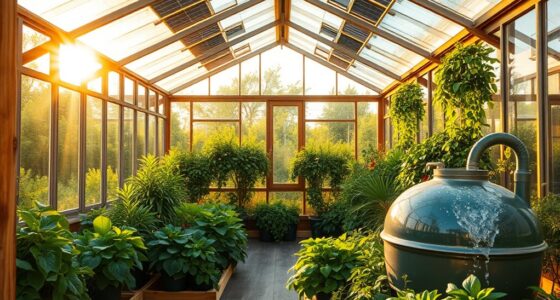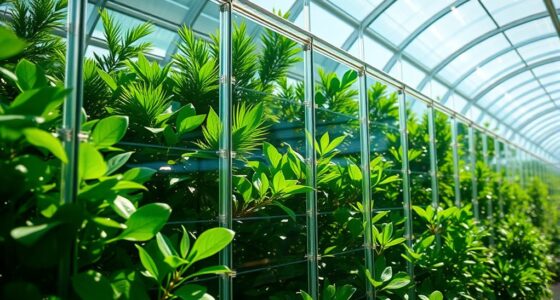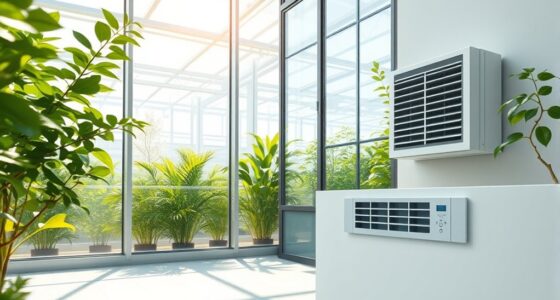Understanding VPD for climate control helps you create an ideal environment for your plants by balancing temperature and humidity. By monitoring and adjusting these factors, you can optimize transpiration, nutrient uptake, and growth while preventing issues like mold or wilting. Maintaining proper VPD levels guarantees your plants stay healthy and productive. Mastering this concept enables you to fine-tune your climate setup and achieve better yields—discover how to do it more effectively as you explore further.
Key Takeaways
- VPD measures the difference between saturated vapor pressure and actual humidity, guiding climate adjustments for optimal plant health.
- Balancing temperature and humidity influences VPD to promote proper transpiration and growth stages.
- Monitoring VPD helps prevent stress, disease, and growth issues caused by overly dry or humid environments.
- Climate control tools like humidifiers and dehumidifiers maintain target VPD levels for specific crop needs.
- Mastering VPD management leads to healthier plants, increased yields, and more efficient indoor gardening.

Vapor Pressure Deficit (VPD) is a essential metric for managing ideal climate conditions in indoor gardening and crop production. It fundamentally measures the difference between the moisture the air can hold when saturated and the actual amount of moisture present. Understanding VPD helps you control the environment to maximize plant health, growth, and yield. When you monitor VPD, you’re directly influencing plant transpiration—the process where plants pull water from their roots and release it through their leaves. Proper transpiration regulation is critical because it affects nutrient uptake, cooling, and overall plant vigor.
VPD is vital for optimizing plant health, growth, and transpiration in indoor gardening environments.
If the VPD is too high, the air becomes dry relative to the plant’s needs. This causes plants to transpire more rapidly, which can lead to water stress, wilting, and slowed growth. On the other hand, if VPD is too low, the air remains overly humid, reducing transpiration rates. When humidity levels are high, plants struggle to release excess moisture, making them more susceptible to diseases like mold or mildew and hampering nutrient absorption. By understanding how VPD influences plant transpiration, you gain a powerful tool for humidity regulation, ensuring your plants stay in an inherently optimal state.
Controlling VPD involves balancing temperature and humidity levels. When you adjust humidity, you’re directly affecting the vapor pressure in the environment. For example, increasing humidity lowers VPD, promoting slower transpiration, which is advantageous during certain growth phases or in cooler environments. Conversely, reducing humidity raises VPD, encouraging plants to transpire more actively, which can be beneficial during the flowering stage or in warmer conditions. The key is to maintain a VPD that aligns with your crop’s specific needs, promoting healthy transpiration without causing stress.
You can fine-tune your climate control systems—like humidifiers, dehumidifiers, and ventilation—to keep VPD within the ideal range. Regularly measuring environmental parameters allows you to make immediate adjustments, preventing issues like over- or under-watering. Additionally, understanding the history of pinball machines offers insight into how technological advancements can improve control systems in climate management. When you understand the relationship between VPD, plant transpiration, and humidity regulation, you’re better equipped to create a stable environment. This not only enhances plant growth but also minimizes stress and disease risks, leading to a more productive indoor garden or crop operation.
Ultimately, mastering VPD means you’re actively managing the microclimate for your plants. By keeping humidity and temperature in check and understanding how they influence transpiration, you create conditions that foster robust growth, strong yields, and healthier plants overall.
Frequently Asked Questions
How Does VPD Influence Plant Transpiration Rates?
VPD directly impacts your plant’s transpiration rates by influencing transpiration regulation through stomatal response. When VPD is high, the air is dry, prompting your plants to close their stomata to conserve water, reducing transpiration. Conversely, low VPD causes stomata to open wider, increasing transpiration. Monitoring VPD helps you manage these responses, ensuring your plants maintain healthy water balance and ideal growth conditions.
Can VPD Be Used to Optimize Indoor Climate Settings?
Think of VPD as your indoor climate’s silent conductor—guiding humidity control and temperature regulation to harmony. Yes, you can use VPD to optimize indoor settings; it’s an essential tool that signals when to adjust humidity and temperature for ideal plant growth. By monitoring VPD, you ensure your environment remains balanced, preventing stress and promoting healthy transpiration. It’s like giving your plants a personalized climate coach.
What Devices Are Best for Measuring VPD Accurately?
You should use a high-quality digital hygrometer with proper calibration to measure VPD accurately. Guarantee the sensor is placed in a representative spot, away from direct sunlight or drafts, for reliable readings. Regular hygrometer calibration helps maintain precision, and correct sensor placement ensures your measurements reflect true environmental conditions. Combining these practices allows you to monitor VPD effectively, optimizing your climate control system for healthier plants or comfort.
How Does VPD Vary Across Different Plant Species?
Think of VPD as a gentle dance between plants and their environment. Different species have their own unique rhythm, adapting to specific VPD levels based on their evolutionary background. As they grow through various stages, their VPD needs shift, influencing their health and development. You’ll find that some plants thrive in higher VPD, while others prefer a more delicate balance, reflecting their natural habitat and adaptation.
What Are the Signs of Incorrect VPD Levels in a Grow Environment?
If your VPD levels are off, you’ll notice humidity imbalance and leaf curling. Too low VPD causes plants to lose moisture rapidly, leading to dry, curled leaves. Conversely, high VPD results in excess humidity, making leaves droop and develop mold. Keep an eye on these signs, and adjust your humidity and temperature settings accordingly to maintain ideal VPD, ensuring healthy, thriving plants.
Conclusion
Remember, knowledge is power, and understanding VPD helps you master climate control. By keeping VPD in check, you create ideal conditions for plant growth and health. Don’t wait until it’s too late—adjust your environment proactively. As the old saying goes, “A stitch in time saves nine.” Stay attentive to VPD levels, and you’ll ensure a thriving, healthy garden or grow space. Keep learning, stay vigilant, and let your plants flourish.










